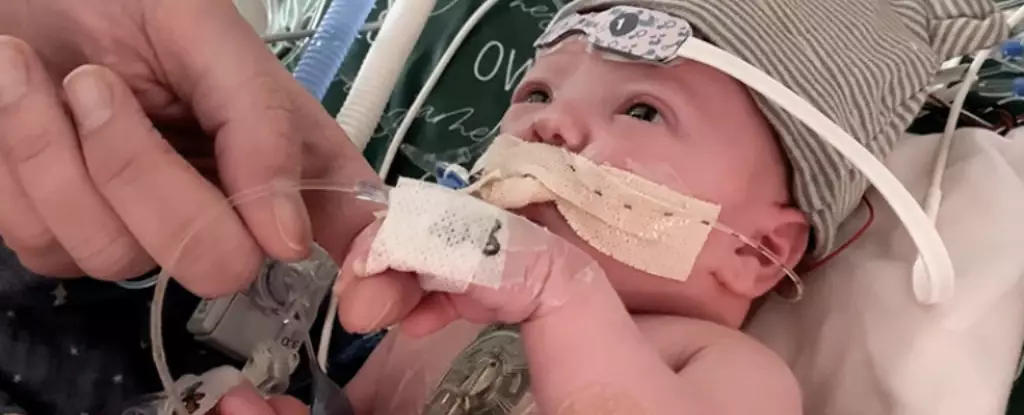In a groundbreaking medical achievement, the first partial heart transplant on a baby has yielded astounding results, promising a hopeful future for those in need of this life-saving procedure. Unlike previous methods, this innovative technique involves incorporating donated heart valves and vessels into the recipient’s native heart, eliminating the need for repeated surgeries. The success of this novel approach in baby Owen Monroe has revolutionized the field of heart transplantation and offers a glimmer of hope for countless children who suffer from congenital heart defects.
Historically, the idea of salvaging native heart tissue and utilizing donor tissue exclusively for replacing defective portions remained unexplored in human trials. However, in 2022, a team of surgeons at Duke University crafted a pioneering surgical strategy that proved to be a remarkable success. By sewing heart valves and vessels extracted from a donor infant into 18-day-old Owen Monroe’s heart, the medical community witnessed a feat never achieved before.
Remarkably, more than a year later, Owen’s heart has grown from the size of a strawberry to that of an apricot, with the transplanted tissue growing seamlessly alongside it. The JAMA-published study documenting Owen’s progress reveals excellent heart function and developmental milestones comparable to those of a typical one-year-old. These unprecedented outcomes suggest that this revolutionary technique has the potential to benefit countless children facing similar challenges.
A Beacon of Hope for Other Children
The successful publication of Owen’s case study represents more than just a single medical success story; it serves as proof that this groundbreaking technology and concept have the potential to transform the lives of numerous children enduring cardiac ailments. Dr. Joseph Turek, the lead surgeon behind this magnificent feat, believes that this pioneering technique can be instrumental in aiding others.
Owen’s parents, Nick and Tayler Monroe, took the courageous decision to proceed with the surgery after learning about their child’s diagnosis of truncus arteriosus, a severe heart defect affecting approximately 250 infants in the United States each year. Unlike traditional treatments that often require full heart transplants or the use of frozen tissues from cadavers, this novel approach offers hope without the associated risks.
While transplanted hearts do grow with the child, they often malfunction over time, leading to a distressing statistic where half of heart transplant recipients do not survive beyond the age of 20. The need for immunosuppressive drugs to prevent organ rejection further complicates matters, as it opens the doors to various health risks, including infections and cancer.
The ingenious nature of Owen’s partial transplant resolves these obstacles. By focusing on integrating valves and vessels instead of the heart muscle itself, the chances of organ rejection diminish significantly. As a result, Owen requires only half the dosage of immunosuppressive drugs that full transplantation recipients typically need. This breakthrough mitigates the risks associated with lifelong immunosuppression and provides new possibilities for enhancing the longevity of transplanted hearts.
Infants diagnosed with truncus arteriosus often face a perilous journey filled with repeated surgeries to replace outgrown grafts. This treatment’s mortality rate stands at an alarming 50 percent during infancy, making it a high-stakes gamble for both patients and their families.
Baby Owen’s inclusion on the heart transplant list presented an additional predicament. With limited time to wait for a donor match, the chance of survival was slim. Owen’s heart failure, which began only a few days after birth, left him too weak for emergency treatments such as heart-lung bypass. It was clear to his parents, Nick and Tayler Monroe, that swift action was necessary to save their son’s life.
The success story of Owen Monroe’s partial heart transplant provides a beacon of hope for children suffering from congenital heart defects. By challenging the established norms and utilizing innovative surgical techniques, the medical community has discovered a path to a brighter future. This groundbreaking procedure not only allows the recipient’s native heart tissue to grow but also reduces the risk of rejection and the need for lifelong immunosuppression.
Moving forward, it is crucial to expand upon this pioneering work and conduct further studies to refine and perfect the technique. With each advancement, we inch closer to a world where heart transplantation becomes a routine and accessible treatment, transforming the lives of countless individuals affected by heart disease. The success of Owen’s journey stands as a testament to human ingenuity and the indomitable spirit of medical progress.


Leave a Reply